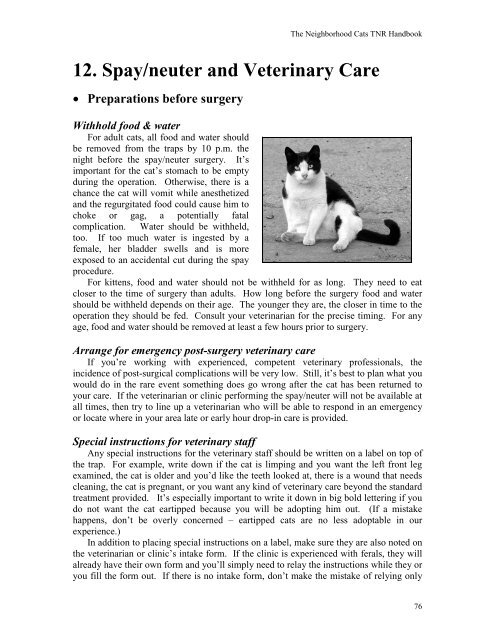You also want an ePaper? Increase the reach of your titles
YUMPU automatically turns print PDFs into web optimized ePapers that Google loves.
The <strong>Neighborhood</strong> <strong>Cats</strong> <strong>TNR</strong> <strong>Handbook</strong><br />
12. Spay/neuter and Veterinary Care<br />
• Preparations before surgery<br />
Withhold food & water<br />
For adult cats, all food and water should<br />
be removed from the traps by 10 p.m. the<br />
night before the spay/neuter surgery. It’s<br />
important for the cat’s stomach to be empty<br />
during the operation. Otherwise, there is a<br />
chance the cat will vomit while anesthetized<br />
and the regurgitated food could cause him to<br />
choke or gag, a potentially fatal<br />
complication. Water should be withheld,<br />
too. If too much water is ingested by a<br />
female, her bladder swells and is more<br />
exposed to an accidental cut during the spay<br />
procedure.<br />
For kittens, food and water should not be withheld for as long. They need to eat<br />
closer to the time of surgery than adults. How long before the surgery food and water<br />
should be withheld depends on their age. The younger they are, the closer in time to the<br />
operation they should be fed. Consult your veterinarian for the precise timing. For any<br />
age, food and water should be removed at least a few hours prior to surgery.<br />
Arrange for emergency post-surgery veterinary care<br />
If you’re working with experienced, competent veterinary professionals, the<br />
incidence of post-surgical complications will be very low. Still, it’s best to plan what you<br />
would do in the rare event something does go wrong after the cat has been returned to<br />
your care. If the veterinarian or clinic performing the spay/neuter will not be available at<br />
all times, then try to line up a veterinarian who will be able to respond in an emergency<br />
or locate where in your area late or early hour drop-in care is provided.<br />
Special instructions for veterinary staff<br />
Any special instructions for the veterinary staff should be written on a label on top of<br />
the trap. For example, write down if the cat is limping and you want the left front leg<br />
examined, the cat is older and you’d like the teeth looked at, there is a wound that needs<br />
cleaning, the cat is pregnant, or you want any kind of veterinary care beyond the standard<br />
treatment provided. It’s especially important to write it down in big bold lettering if you<br />
do not want the cat eartipped because you will be adopting him out. (If a mistake<br />
happens, don’t be overly concerned – eartipped cats are no less adoptable in our<br />
experience.)<br />
In addition to placing special instructions on a label, make sure they are also noted on<br />
the veterinarian or clinic’s intake form. If the clinic is experienced with ferals, they will<br />
already have their own form and you’ll simply need to relay the instructions while they or<br />
you fill the form out. If there is no intake form, don’t make the mistake of relying only<br />
76


